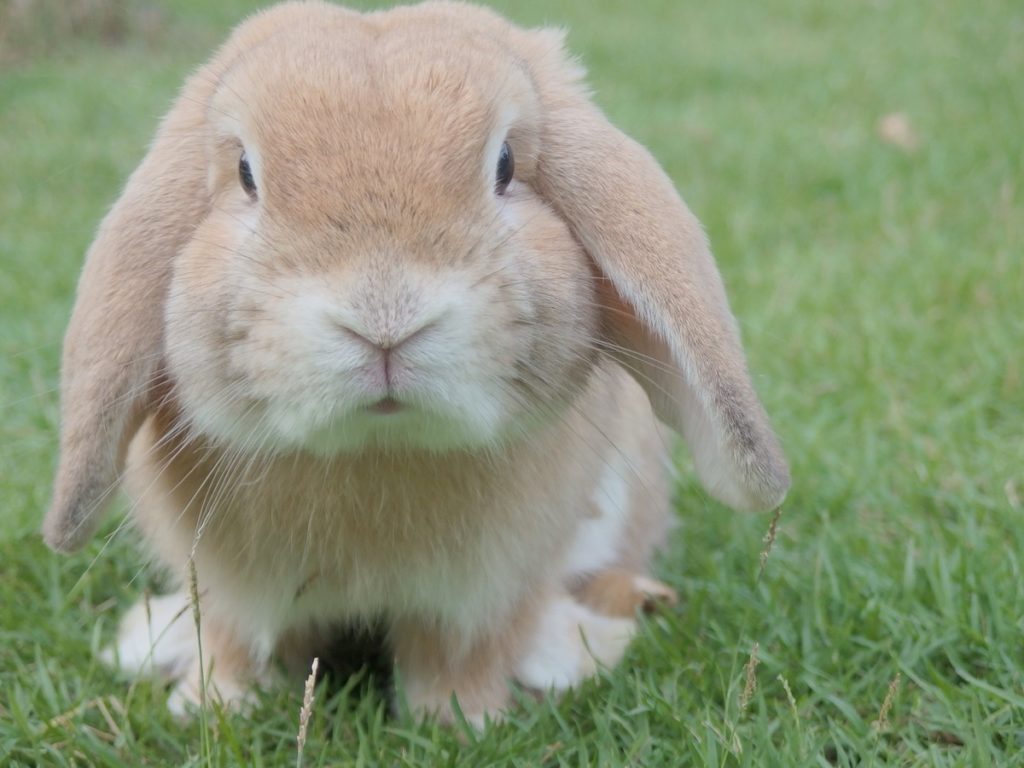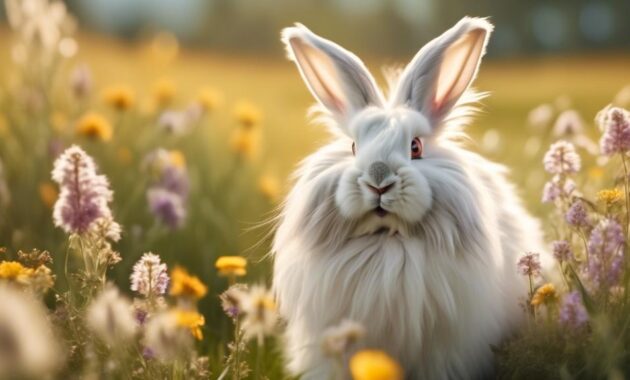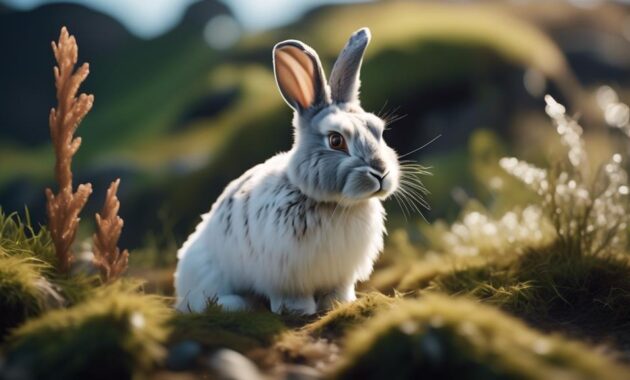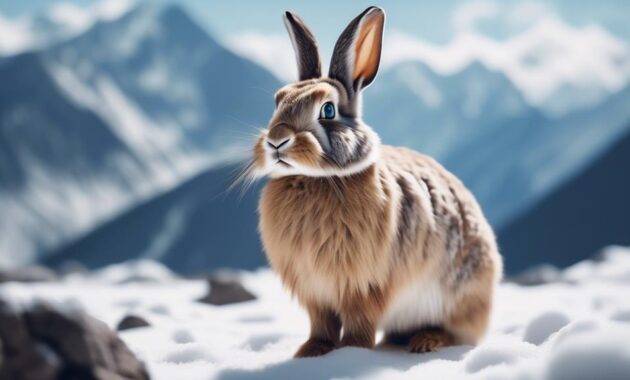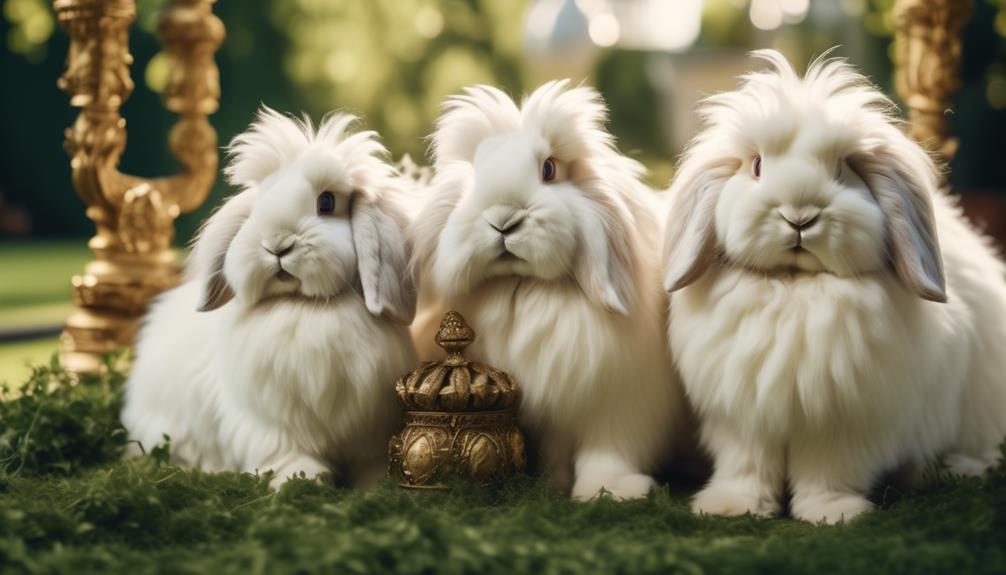
Are you ready to embark on a journey into the luxurious world of German Angora rabbits?
Imagine stepping into a realm where elegance and charm reign supreme, where fluffy companions await to capture your heart. These regal creatures possess a beauty that is unmatched, with their silky coats and captivating personalities.
But there is so much more to discover. From their unique care requirements to the fascinating history of this breed, prepare to be captivated by the enchanting world of German Angora rabbits.
Get ready to uncover the secrets that lie within, as we unravel the mysteries of these magnificent creatures and the joy they can bring to your life.
Key Takeaways
- German Angora rabbits have a large size and a lifespan of 7-12 years, making them a long-term commitment for owners.
- They require regular grooming and shearing every 3 months to maintain their long, fine, and woolen hair.
- German Angora rabbits are friendly, docile, and affectionate, making them suitable for families with children.
- Their wool is resistant to matting and can be spun into yarn, making them valuable for fiber production.
Physical Characteristics and Care Requirements
To properly care for German Angora rabbits, it’s important to understand their physical characteristics and specific care requirements. German Angora rabbits are large in size and can live for 7-12 years. They weigh between 5.5-11.5 lbs and have a cylindrical body shape.
These rabbits are suitable for both indoor and outdoor living and are good with older children, young children, single owners, seniors, and first-time owners. Their diet should mainly consist of hay to prevent wool block, and their enclosure should be safe and comfortable.
Regular grooming and shearing every 3 months are necessary. Consider spaying or neutering to minimize health risks. German Angora rabbits have a long, fine, and woolen coat, with the common color being ruby-eyed white.
They’ve a friendly, docile, and affectionate temperament, making them suitable for families with children.
German Angora Rabbit Breed History
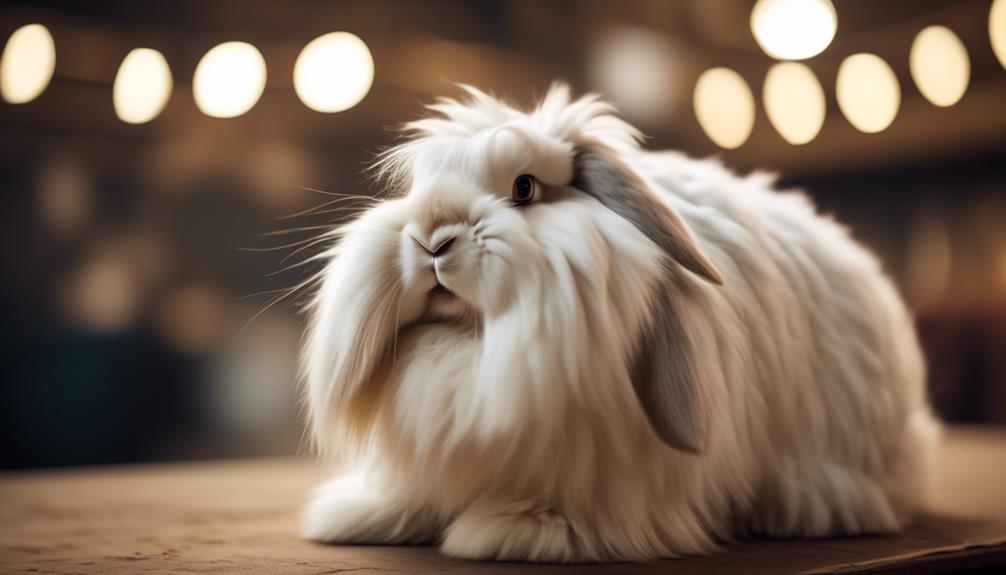
German Angora Rabbit Breed History dates back to the 1920s when German breeders aimed to improve the breed for commercial purposes. Through selective breeding in the 1960s, they were able to increase wool production in these rabbits.
It’s interesting to note that the German Angora Rabbit isn’t recognized by the American Rabbit Breeders Association, but it has its own association called The International Association of German Angora Rabbit Breeders.
The German Angora Rabbit is similar in appearance to the English Angora Rabbit. Its coat is long, fine, and woolen, and it’s resistant to matting. The most common color is ruby-eyed white, with a lighter undercoat and more intense top fur.
Coat and Colors of German Angora Rabbit
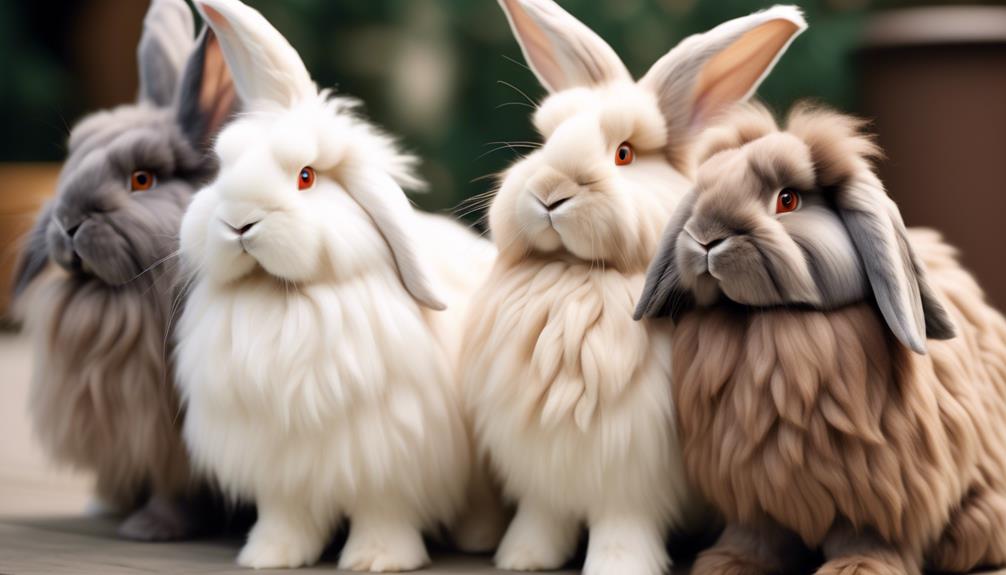
The German Angora Rabbit’s coat is known for its long, fine, and woolen hair. This breed has a unique non-molt gene, which means their fur doesn’t shed. Their wool is resistant to matting, so regular brushing or grooming isn’t necessary.
The German Angora Rabbit’s coat is so versatile that it can be spun into yarn. The most common color for this breed is ruby-eyed white, with a lighter undercoat and more intense top fur. The colors of their coat give them a luxurious and elegant appearance.
With their beautiful and soft wool, German Angora Rabbits are truly a sight to behold.
Temperament and Behavior of German Angora Rabbit
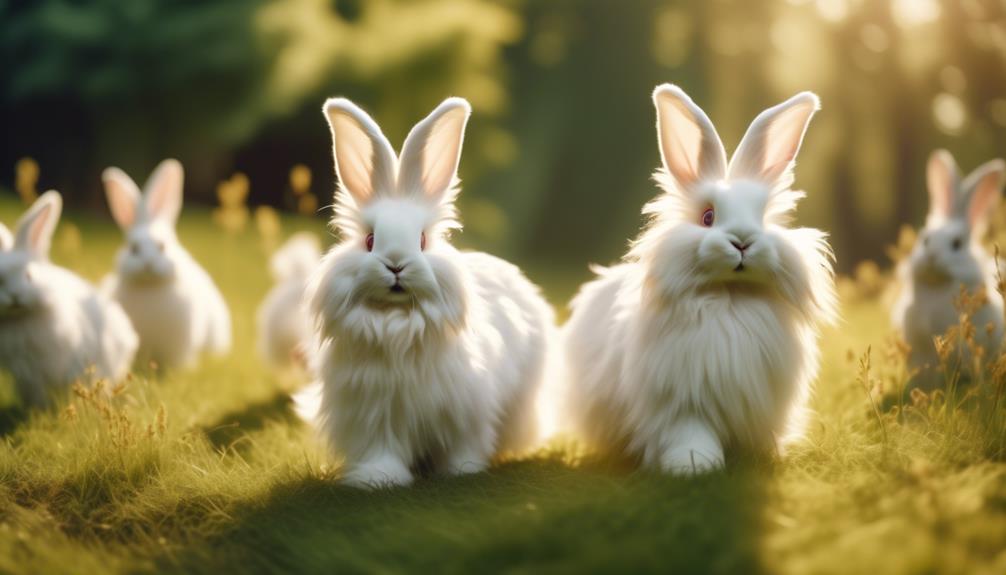
With their luxurious and elegant appearance, it’s time to explore the friendly and sociable temperament of German Angora Rabbits. These rabbits are known for their docile and affectionate nature, making them a great choice for families with children. They can be trained and enjoy human touch and grooming, showcasing their intelligence and love for play.
German Angora Rabbits have a sociable temperament and their non-shedding fur adds to their suitability for families. However, it’s important to teach children how to properly interact with the rabbit to avoid any harm.
With their friendly and sociable nature, German Angora Rabbits bring joy and companionship to their owners, making them a delightful addition to any home.
Other Angora Rabbit Breeds
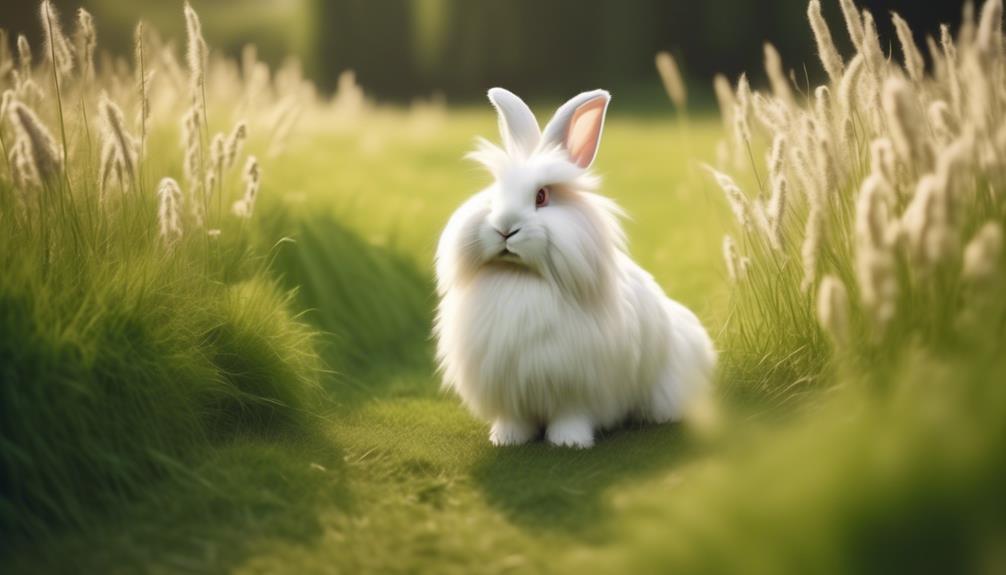
If you’re interested in exploring different breeds of Angora rabbits, there are several options to consider.
One of the oldest breeds is the English Angora Rabbit, which originated from Ankara, Turkey. It was classified into French and English types in 1939 and officially separated into two breeds in 1944. Known for their docile and sociable temperament, English Angoras make wonderful companions.
Another breed to consider is the Satin Angora Rabbit, created by breeder John C. Fehr in 1930. They’ve a commercial body type with slightly tufted ears and are often used as fiber animals.
The French Angora Rabbit closely resembles the original Angora brought from Turkey and is one of the four recognized Angora breeds by the ARBA.
Lastly, there’s the Giant Angora Rabbit, known for its larger size and friendly temperament. Regular grooming is necessary due to its long coat.
Physical Characteristics
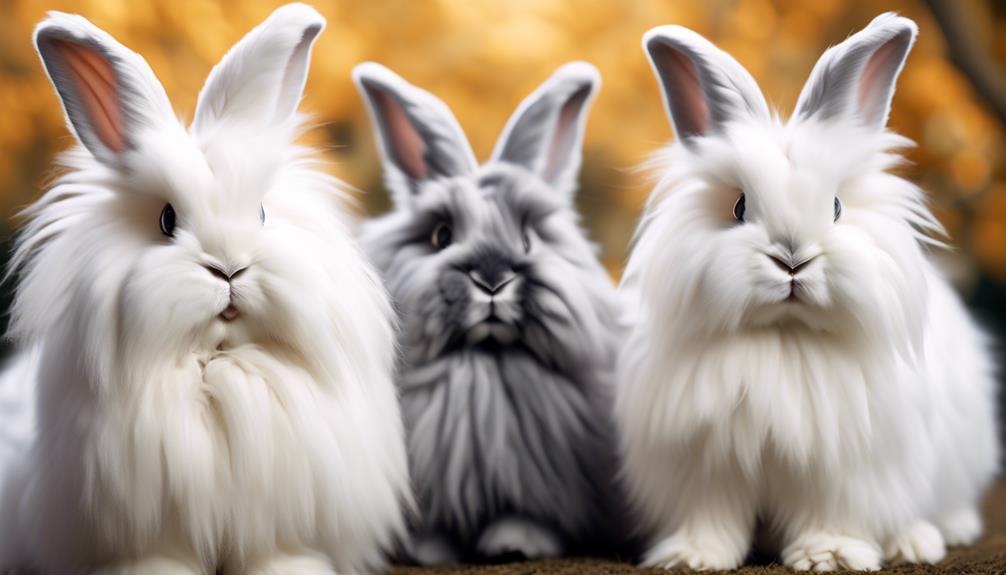
As we move on to discussing the physical characteristics of German Angora rabbits, let’s take a closer look at their distinct features and unique attributes. German Angora rabbits are known for their large size, weighing between 5.5 and 11.5 pounds. They have a cylindrical body shape, making them visually striking. These rabbits have long, fine, and woolen hair, which is resistant to matting and does not require regular brushing or grooming. Their coat can be spun into yarn, making them a valuable breed. The most common color for German Angora rabbits is ruby-eyed white, characterized by a lighter undercoat and more intense top fur. With their luxurious coat and impressive size, German Angora rabbits are truly a sight to behold.
| Physical Characteristics | Unique Attributes |
|---|---|
| Large size | Cylindrical body shape |
| Weight range of 5.5-11.5 lbs | Long, fine, and woolen hair |
| Common color: ruby-eyed white | Coat can be spun into yarn |
Lifespan and Weight Range
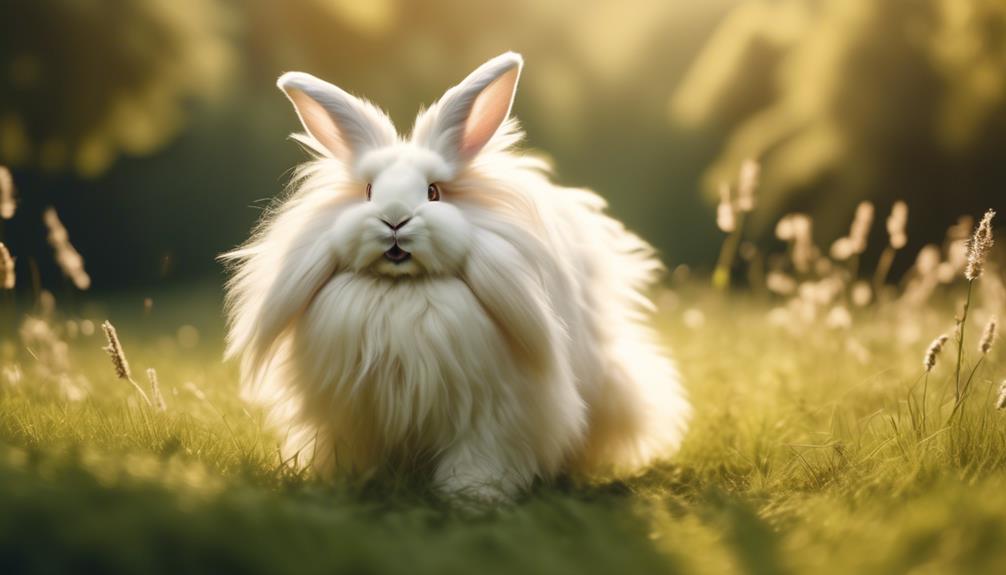
German Angora rabbits have a lifespan of 7-12 years and weigh between 5.5 and 11.5 pounds. These rabbits can live a relatively long time compared to other breeds, providing you with many years of companionship.
With proper care and nutrition, you can ensure that your German Angora rabbit lives a healthy and happy life. It’s important to monitor their weight and consult with a veterinarian if you notice any significant changes.
As for their weight range, German Angora rabbits are considered to be a medium-sized breed. Their weight can vary within the range of 5.5 to 11.5 pounds, depending on factors such as genetics, diet, and overall health.
Suitable Living Environment
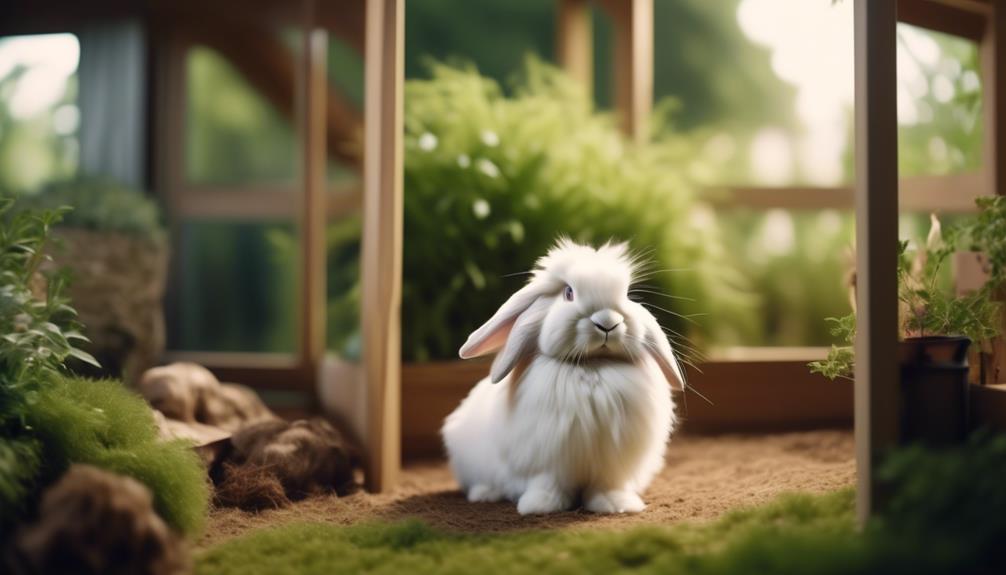
To provide a suitable living environment for your German Angora rabbit, it’s important to create a safe and comfortable enclosure, whether indoors or outdoors.
Here are three key factors to consider:
1) Space: Your German Angora rabbit will need ample space to hop and explore. Provide a large enclosure that allows for plenty of movement and exercise.
2) Security: Ensure that the enclosure is secure and free from potential hazards. Use sturdy materials to prevent escapes and protect your rabbit from predators.
3) Comfort: Line the enclosure with soft bedding materials, such as straw or fleece, to create a cozy and comfortable space for your rabbit. Additionally, provide hiding spots and toys to keep them mentally stimulated.
Compatibility With Children and Seniors
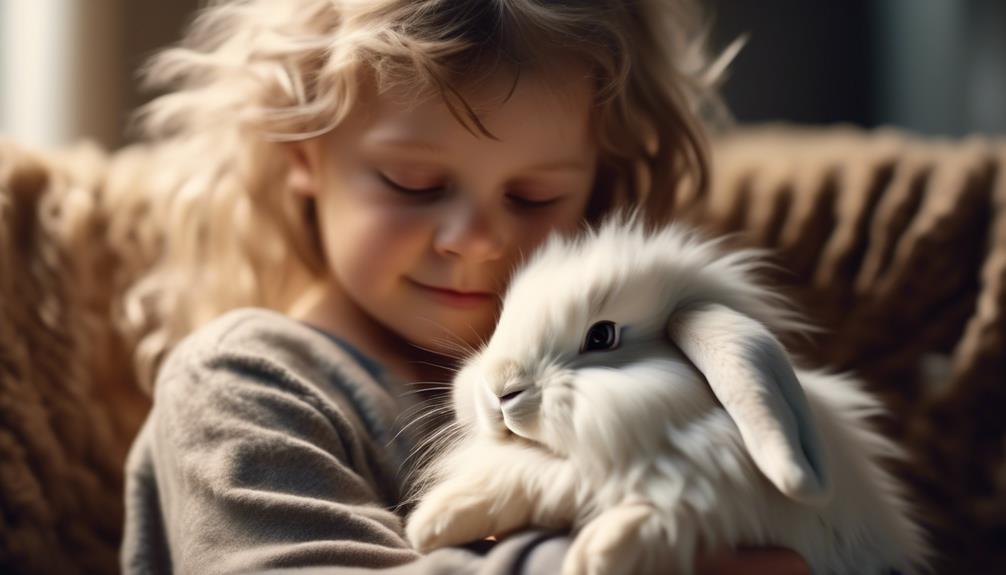
When considering the compatibility of German Angora rabbits with children and seniors, it’s important to understand their sociable temperament and non-shedding fur.
German Angora rabbits have a friendly and docile nature, making them suitable for families with children. They can be trained and enjoy human touch and grooming.
Additionally, their non-shedding fur is a great advantage for households with seniors who may have allergies or difficulty cleaning up after a shedding pet.
The rabbits’ sociable temperament and non-shedding fur make them a wonderful companion for both children and seniors. However, it’s crucial to teach children how to properly interact with the rabbits to avoid causing harm.
With proper care and handling, German Angora rabbits can bring joy and companionship to people of all ages.
Diet and Grooming Needs
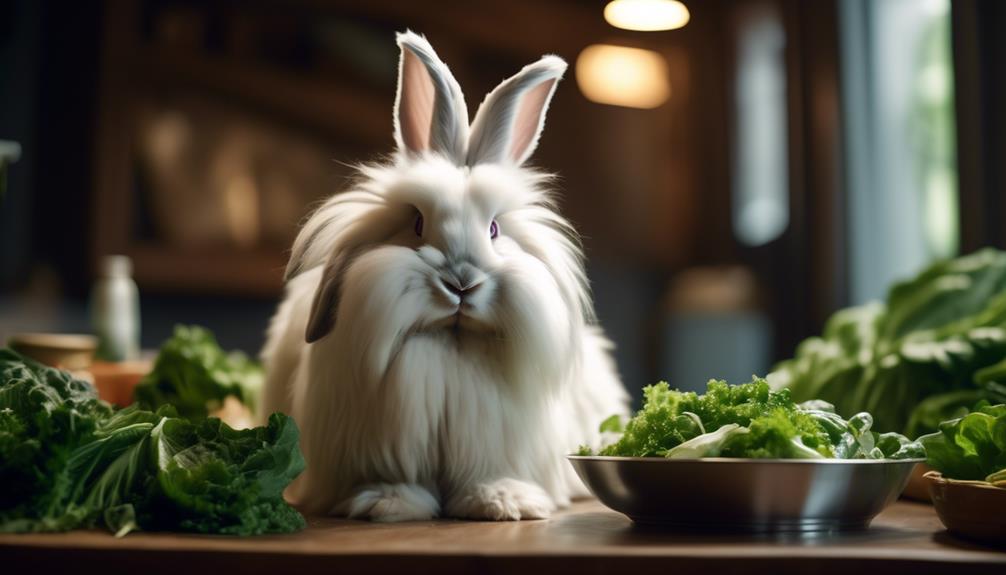
To ensure the health and well-being of your German Angora rabbit, it’s important to understand their specific diet and grooming needs. Here are the key points to keep in mind:
- Diet: German Angora rabbits should have a diet that consists mainly of hay. This is important to prevent wool block, a condition where ingested fur forms a blockage in the digestive system. Supplement their diet with fresh vegetables, high-quality rabbit pellets, and limited amounts of fruits.
- Grooming: Regular grooming is crucial for German Angora rabbits due to their long, fine, and woolen hair. They should be groomed and sheared every three months to prevent matting and maintain their coat’s health. Consider learning proper grooming techniques or seeking professional help to ensure their coat stays in top condition.
- Spaying or Neutering: Consider spaying or neutering your German Angora rabbit to minimize health risks and territorial marking. This procedure can also help with behavioral issues and improve their overall well-being.
Spaying or Neutering Considerations
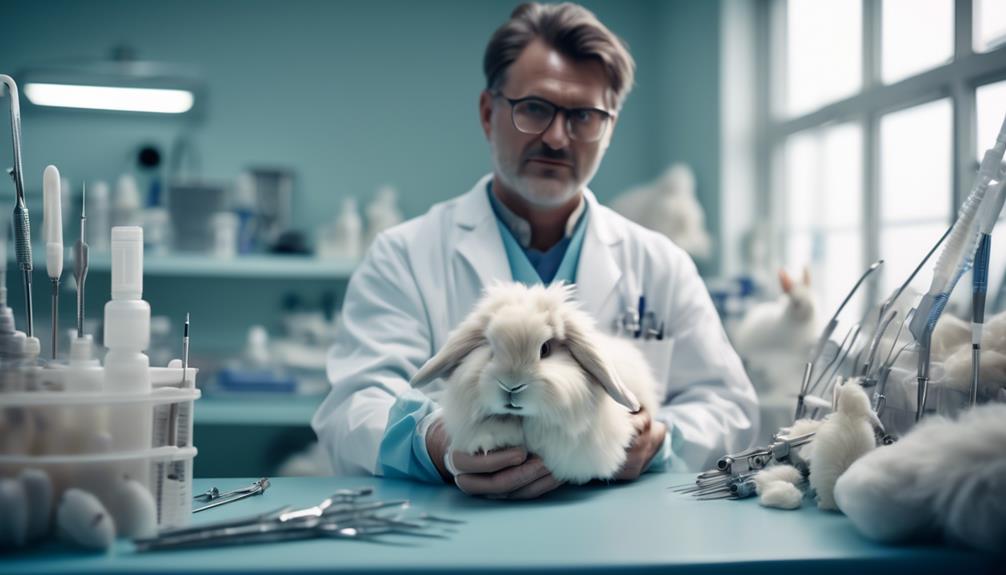
Now let’s explore the important considerations when it comes to spaying or neutering your German Angora rabbit.
Spaying or neutering your rabbit can have numerous benefits for their health and behavior. It can help prevent certain health issues such as uterine cancer in females and testicular cancer in males. Additionally, it can help reduce aggressive and territorial behavior, as well as decrease the risk of your rabbit marking their territory with urine.
Spaying or neutering is typically recommended between four to six months of age, but it’s best to consult with your veterinarian to determine the appropriate timing for your specific rabbit.
It’s important to note that the procedure should only be performed by a qualified veterinarian experienced in rabbit surgeries to ensure the safety and well-being of your German Angora rabbit.
Long, Fine, and Woolen Hair
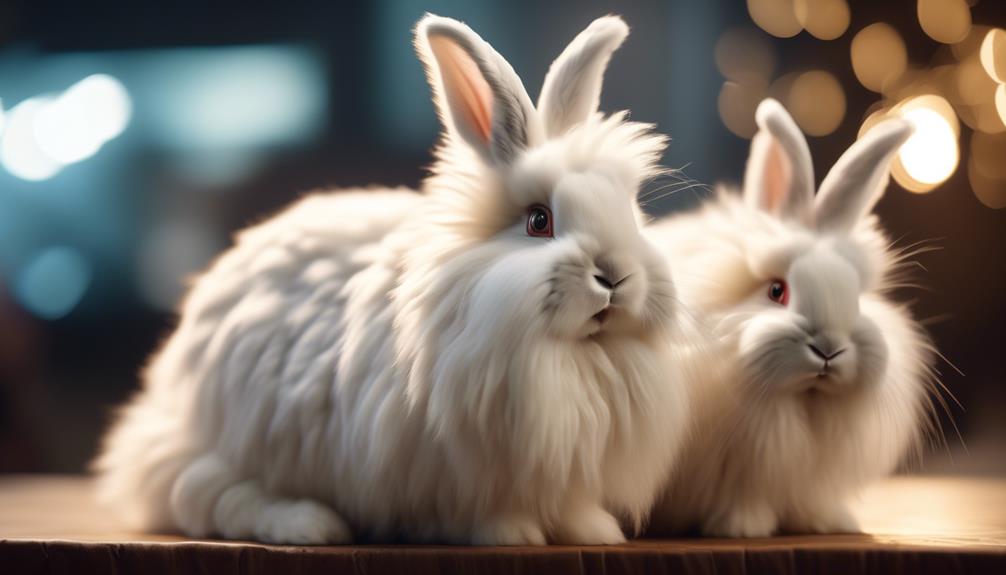
German Angora rabbits have long, fine, and woolen hair. This luxurious coat is a defining characteristic of the breed, making them highly sought after for their beautiful fur.
Here are three key things to know about the hair of German Angora rabbits:
- Length: The hair of German Angora rabbits can grow quite long, reaching several inches in length. This gives them a stunning appearance and adds to their charm.
- Fineness: Not only is their hair long, but it’s also incredibly fine. This fine texture adds to the softness and silkiness of their coat, making it a pleasure to touch.
- Woolen: The hair of German Angora rabbits is often described as woolen. This means that it has a dense and fluffy texture, similar to that of sheep’s wool. This woolen hair contributes to their overall plush and luxurious appearance.
With their long, fine, and woolen hair, German Angora rabbits truly stand out as a breed known for their exceptional coat.
Non-Molt Gene and Shedding
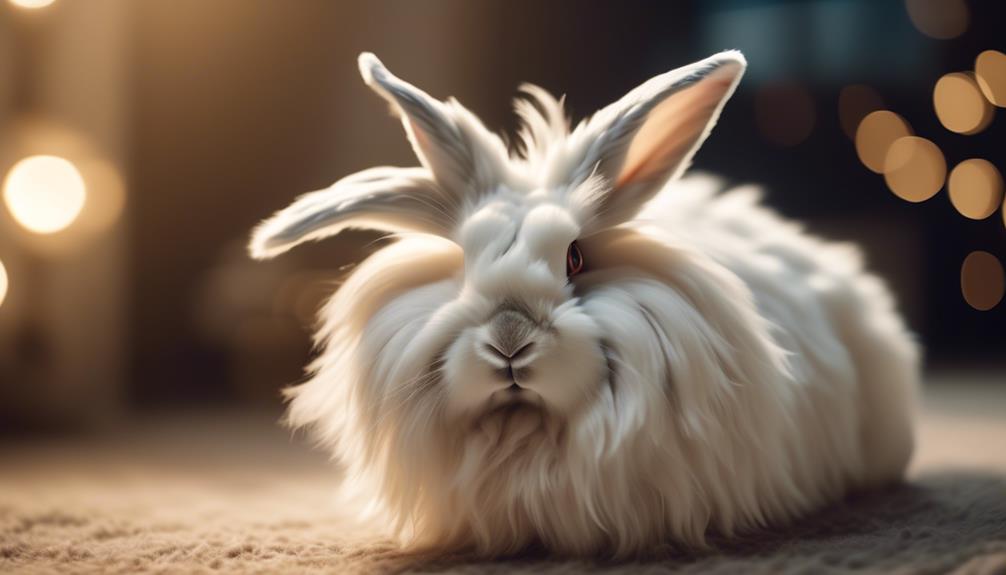
The German Angora rabbit’s coat is unique due to its non-molt gene, which prevents shedding of fur. Unlike other rabbits that shed their fur, German Angoras retain their luxurious coat year-round.
This non-molt gene is a remarkable characteristic that sets them apart from other breeds. With this gene, you won’t have to worry about finding fur all over your house or dealing with excessive grooming.
German Angoras’ wool is resistant to matting and doesn’t require regular brushing or grooming. This makes them low maintenance compared to other breeds.
The non-molt gene also allows their coat to be spun into yarn, making it a valuable resource for crafters and fiber enthusiasts.
Wool Spinning and Common Colors
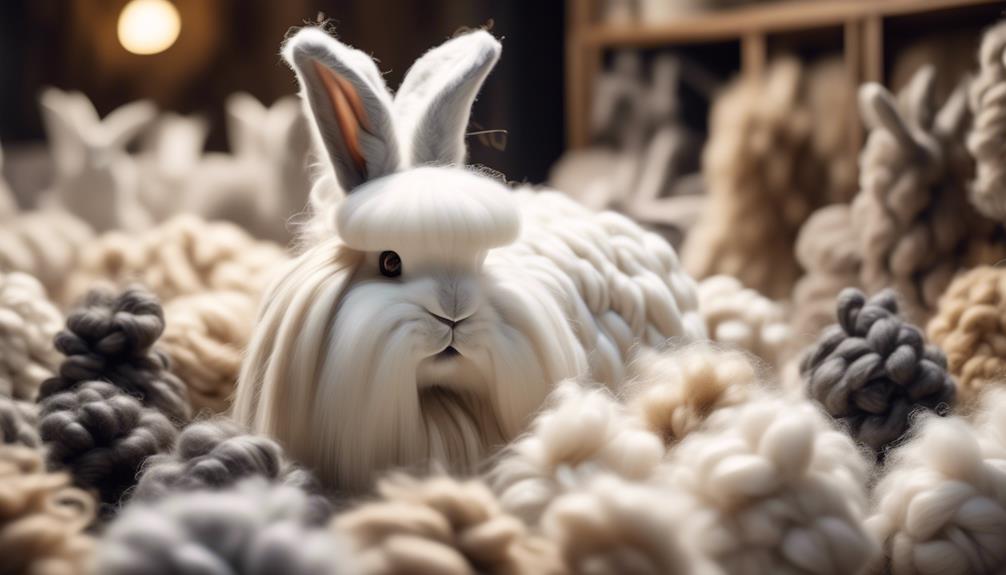
With their non-molt gene and luxurious coat, German Angora rabbits aren’t only low maintenance but also a valuable resource for wool spinning and come in a variety of common colors. Here are three key points about wool spinning and common colors of German Angora rabbits:
- Wool Spinning: The long, fine, and woolen hair of German Angora rabbits can be spun into yarn. The wool is resistant to matting, eliminating the need for regular brushing or grooming. This makes German Angora rabbits a great choice for those interested in fiber arts and crafting.
- Common Colors: While the most common color of German Angora rabbits is ruby-eyed white, their coats can also come in other shades. These include various shades of white, cream, gray, fawn, and even black. The lighter undercoat and more intense top fur create a beautiful contrast in their appearance.
- Variety and Versatility: The wide range of colors in German Angora rabbits allows for versatility in crafting projects. Whether you’re looking to create a soft and fluffy scarf or a vibrant and unique sweater, the different color options provide endless possibilities for creative expression.
Friendly and Trainable Temperament
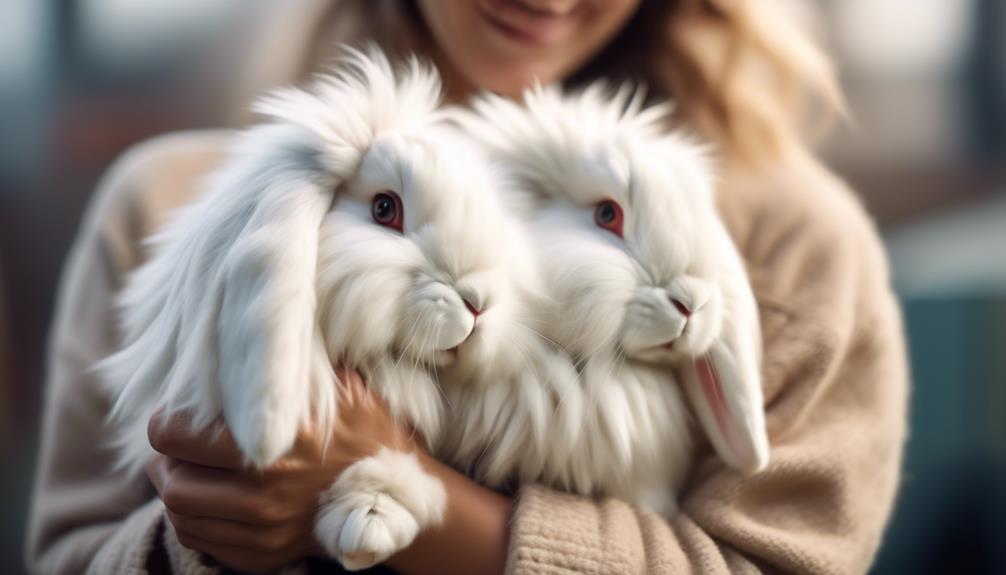
When it comes to their temperament, German Angora rabbits are known for being friendly and trainable. They’ve a naturally docile and affectionate nature, making them great companions. These rabbits enjoy human contact and can be easily trained to respond to commands and cues.
Their intelligence and willingness to learn make them ideal for teaching tricks and participating in agility courses. German Angora rabbits are also well-suited for families with children, as they’re sociable and enjoy interacting with people of all ages.
Their non-shedding fur is an added advantage, as it reduces the risk of allergies and makes them easier to handle. Overall, the friendly and trainable temperament of German Angora rabbits makes them a delightful addition to any household.
Frequently Asked Questions
How Much Does a German Angora Rabbit Cost?
A German Angora rabbit can cost anywhere from $50 to $150, depending on various factors such as age, lineage, and show quality. Prices may vary, so it’s best to check with local breeders or rescue organizations.
Can German Angora Rabbits Be Litter Trained?
Yes, German Angora rabbits can be litter trained. With consistency and patience, you can teach them to use a litter box. Provide a suitable litter box and reward them for using it correctly.
Are German Angora Rabbits Prone to Any Specific Health Issues?
German Angora rabbits are generally healthy, but they can be prone to certain issues. It’s important to monitor their diet to prevent wool block and consider spaying or neutering to minimize health risks and territorial marking.
Can German Angora Rabbits Be Kept With Other Pets, Such as Dogs or Cats?
Yes, German Angora rabbits can be kept with other pets like dogs or cats, but careful introductions and supervision are necessary to ensure everyone’s safety.
How Often Should German Angora Rabbits Be Sheared?
You should shear your German Angora rabbit every 3 months to maintain their coat. Regular grooming is necessary to prevent matting and keep them comfortable.
Are German Angora Rabbits and Holland Lop Rabbits Similar in Care Needs and Temperament?
When it comes to the care needs and temperament, there are some similarities between German Angora rabbits and Holland Lop rabbits. Both require regular grooming due to their long, soft fur. They are also known for their friendly and docile temperament, making them great pets for families. For more adorable holland lop rabbits information, be sure to consult a rabbit care guide.
Conclusion
So, if you’re looking for a luxurious and unique pet, look no further than the world of German Angora rabbits. With their stunning appearance, friendly temperament, and low grooming requirements, they’re the perfect addition to any family.
Whether you’re a first-time owner or a seasoned rabbit enthusiast, these magnificent creatures will bring joy and enchantment to your life.
Don’t miss out on the opportunity to experience the luxurious world of German Angora rabbits.

